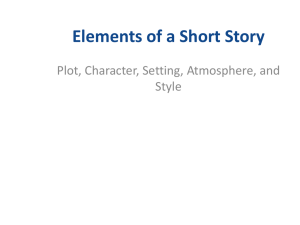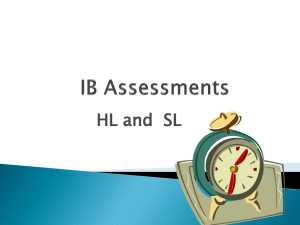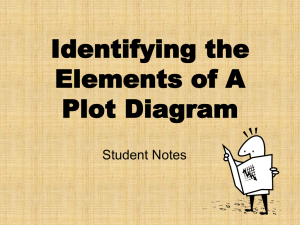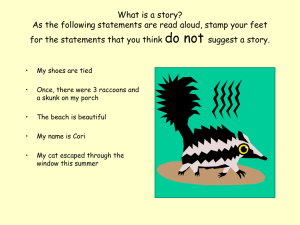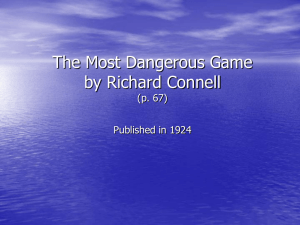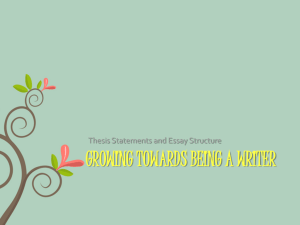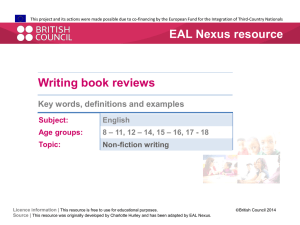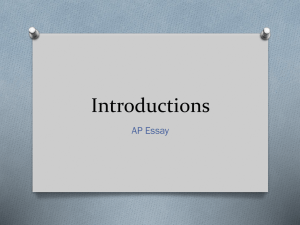What is a Short Story?
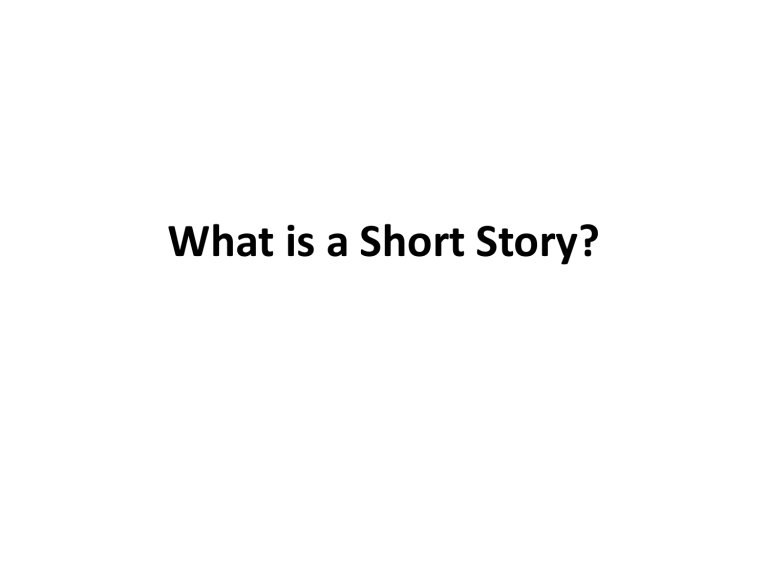
What is a Short Story?
Table of Contents
Short Stories for English 102
TABLE OF CONTENTS
1. The Conversation of
Birds (41)
2. The Three Little Pigs
& The Real Story
3. On the Sidewalk
Bleeding
4. The Michelle I Know
(16)
5. A Sound of Thunder
6. Two Kinds (199)
7. I’ve Got Gloria (170)
8. The Toll House
9. Shoplifting (Three
Tales)
10. The Crystal Stars
Have Just begun to
Shine (60)
11. Excerpt from Goon
Squad (234)
12. Crime Doesn’t Pay
“Part of the beauty of all literature,” commented novelist and short story writer F. Scott Fitzgerald, is that “you discover that your longings are universal longings, that you’re not lonely and isolated from anyone. You belong.”
What is a Short Story?
What is a Short Story?
In your notebook, write your own definition of what a short story is.
Do not write “A story that is short”! Use what you know about short stories in the past.
Below your definition, brainstorm about short stories
– any words you have learned connected to short stories, titles of stories, authors, etc.
Now, let’s share.
The Short Story: Some Definitions
• A short story is a “packed capsule of life”.
• The short story gives the illusion of life. It is a tiny capsule of living, a moment or two in the lives of other people.
• A short story is a story that is under 40,000 words in length
(so, a “short story”).
• A short story is a story that can be read in a single sitting.
…but there is much more to the genre called “the short story”!
Vocabulary
medium – an intervening instrument by which something is conveyed or accomplished theme – The theme of a story represents what the protagonist (main character) and/or reader learns about life. It is the “message” that the author is sending through the story – the story is the medium for the message.
Vocabulary
genre – a class or category having a particular form, technique, content, etc. E.g. poetry, novels, fantasy, science fiction prose – the ordinary form of spoken or written language, as distinguished from poetry or verse fiction – the class of literature comprising works of imaginative narration
Besides being shorter, how is a short story different from a novel?
“Short stories and novels seem to begin in very different ways in my mind. With a novel, the main characters come first; they grow slowly in the imagination until I feel I know them well… Most short stories I’ve written seem to be triggered off by some event, either in my own life or something I’ve observed. The characters in a short story seem just as real to me as the characters in a novel, but I have not seen them, in my mind, in as many situations – they are visualized more in relation to one main situation. …
One form is not better than the other. They simply do not serve the same function…
When I write a novel, I feel rather like a juggler trying to keep a dozen themes spinning up there in the air. In my [short] stories, on the other hand, there tends to be one central theme.”
Margaret Laurence
An Oral Tradition—sept 9
Short stories date back to oral story-telling traditions which originally produced epics such as
Homer's Iliad and Odyssey. Oral narratives were often told in the form of rhyming to help the orator remember the story.
Fables: tales with a "moral," were invented in the 6th century BCE by a Greek slave named Aesop. These ancient fables are today known as Aesop's Fables.
The other ancient form of short story, the anecdote, was popular under the Roman Empire. Anecdotes functioned as a sort of parable, a brief realistic narrative that embodies a point.
Some example follow.
Aesop
• THE BOY WHO CRIED 'WOLF'
• There was a boy tending the sheep who would continually go up to the embankment and shout, 'Help, there's a wolf!' The farmers would all come running only to find out that what the boy said was not true. Then one day there really was a wolf but when the boy shouted, they didn't believe him and no one came to his aid.
The whole flock was eaten by the wolf.
The story shows that this is how liars are rewarded: even if they tell the truth, no one believes them.
The Ant and the Grasshopper
In a field one summer's day a Grasshopper was hopping about, chirping and singing to its heart's content. An Ant passed by, bearing along with great toil an ear of corn he was taking to the nest. "Why not come and chat with me," said the Grasshopper,
"instead of toiling and moiling in that way?" "I am helping to lay up food for the winter," said the Ant, "and recommend you to do the same." "Why bother about winter?" said the
Grasshopper; we have got plenty of food at present." But the
Ant went on its way and continued its toil. When the winter came the Grasshopper had no food and found itself dying of hunger, while it saw the ants distributing every day corn and grain from the stores they had collected in the summer. Then the Grasshopper knew: It is best to prepare for the days of necessity.
Fables
• A fable is a succinct story, in prose or verse, that features animals, plants, inanimate objects, or forces of nature which are anthropomorphized (given human qualities), and that illustrates a moral lesson
(a "moral"), which may at the end be expressed explicitly in a pithy maxim.
• A fable differs from a parable in that the latter
excludes animals, plants, inanimate objects, and forces of nature as actors that assume speech and other powers of humankind.
• Now it is time to write your own! Share in groups.
The Short Story
The Short Story Genre
• The oldest form of literature.
• Prose fiction.
• A distinct genre (like poetry, novels, plays).
• Every word counts! There is a strong focus on word choice, because this is how the author prunes and polishes the piece to meet his/her objective(s).
The Short Story Genre
History of the Short
Story Genre
Ancient Times:
The Bible – Old Testament 750-350
B.C.E.
Middle Ages (800-1400 A.D.)
Arabia – One Thousand and One
Nights by Scheherezade
Spain – Exemplary Tales by
Cervantes
England – Canterbury Tales by
Chaucer
• …but in the Middle Ages, the genre had not taken shape as a recognizable form.
The Short Story Genre
History of the Short
Story Genre
The modern short story genre took shape in the 19 th century simultaneously in:
Germany (Hoffman, Brothers
Grimm)
Russia (Pushkin, Gogol)
France (Balzac, DeMaupassant)
U.S.A. (Washington Irving, Edgar
Allen Poe)
The short story became a favorite form of entertainment for the emerging middle class.
Grammar Break!
Noun – A word that refers to people, places or things.
Common Noun – A noun that refers to a general person, place, or thing. (e.g. boy, dog, city, book)
Proper Noun – A noun that refers to a specific person, place, or thing. Proper nouns are essentially nouns with names, and are always capitalized. (e.g.
Johnny, Spot, Saint John, Cue for Treason)
Common and Proper Nouns Exercise
Write the following words in your notebook. When you do, indicate whether each is a Proper Noun (PN) or
Common Noun (CN).
Begin the word with the proper capital or lower-case letter.
alex river hampton high school sobey’s easter cd player moncton orange tim horton’s
You have 3 minutes to complete this exercise. I will be calling people randomly for answers.
Some other popular short stories:
• Arabia – One Thousand and One Nights by
Scheherezade
• Geoffrey Chaucer’s Canterbury Tales
• Cervantes, Don Quixote
Arabia – One Thousand and One
Nights by Scheherezade
The best known stories from The Nights include "Aladdin's Wonderful Lamp,"
"Ali Baba and the Forty Thieves," and "The Seven Voyages of Sinbad the
Sailor."
Arabian Nights
»
» "Aladdin Saluted Her with Joy", Arabian Nights, the illustration, 1928, shows the Chinese-esque setting of the original tale.
Aladdin in the Magic
Garden, an illustration by
Max Liebert .
Aladdin, as seen in the Disney version.
Geoffrey Chaucer (c. 1343 –
October 25, 1400?)
He is an English author, poet, philosopher, bureaucrat, courtier and diplomat.
Although he wrote many works, he is best remembered for his unfinished frame narrative The Canterbury
Tales. He is sometimes called the father of English literature. His story collection is dated to the 14 th
Century.
Cervantes
Or, The Prince of Wits
1547-1616
Don Quixote: Published in two volumes a decade apart, Don Quixote is the most influential work of literature to emerge from the Spanish
Golden Age and perhaps the entire Spanish literary canon. As a founding work of modern
Western literature, it regularly appears at the top of lists of the greatest works of fiction ever published.
History of the Short Story—sept 12
Author Research Project
See Handout
The Short Story as Art
Purpose and Audience
Artist Medium
(art)
Receiver
The communication model above demonstrates the relationship between an artist and the receiver of the art.
When an artist sets out to create art, she/he determines three main things:
Purpose: What am I trying to accomplish?
Audience: For whom am I creating this art?
Medium: What art form am I going to use?
In terms of a short story, the model looks more precisely like this:
Author Short Story Reader
Short stories are not the spontaneous product of the natural world; the author deliberately brings his/her writing talent to bear, in order to bring something to the reader (the purpose).
PURPOSE: Why Short Stories?
There are principally THREE reasons for reading/writing short stories:
1. To entertain
The first purpose of a short story is to enjoy
it. Authors want you to enjoy a short story
(and usually to pay money for it).
Why Short Stories?
1. To entertain
2. To teach
Often, the author has a particular point of view on an issue that he/she wants to share. The story is the medium the author uses to convey the message.
This is the stage of analysis at which understanding symbol, meaning, and other literary devices is important.
Why Short Stories?
1. To entertain
2. To teach
3. To raise questions
Often, a specific “message” from the author is not clear; other times, there is no “message” from the author per se.
Rather, the author might be simply trying to get the reader to think about things in a new way, or to
question things that the reader might have already made up his/her mind about.
Why Short Stories?
1. To entertain.
2. To teach.
3. To raise questions.
It is important to remember that each short story can have two or all three purposes at the same time.
“The Conversation of Birds”
Read the short story,
“The Conversation of Birds”.
With a partner, discuss:
1. What the aim(s) of the author might have been for writing the story.
2. What is the theme or message?
3. Write a persuasive paragraph arguing your opinion.
“The Conversation of Birds ”
Crossroads 10 pp. 41-45.
Complete “Responding to the Story” b., c., d., and e. Also, write down the definition of simile on p.
46, and find 3 examples of similes in the story.
How to Analyze a Short Story
How to Analyze a Short Story
In the study of English as a discipline, you must approach texts in a variety of ways.
The only way to truly analyze a work of fiction is to return to it more than once, with different purposes in mind.
In a tightly-constructed short story, every element – and often every word – is chosen deliberately.
When you analyze a short story, it is to see the author’s design. When you can see the author’s work, it raises the level of enjoyment (from an initial “knee-jerk” reaction to an intellectual one).
How to Analyze a Short Story
First Reading
Second Reading
Subsequent Readings
Read primarily to enjoy.
Take notes on anything that seems unusual, particularly vivid, jarring, or difficult to understand.
Bring your analytical skills to bear.
Look for literary devices, and think about how they operate in the story.
How to Analyze a Short Story
Take notes when you read a short story.
Remember:
WHEN YOU READ,
YOU UNDERSTAND ONCE;
WHEN YOU WRITE,
YOU UNDERSTAND TWICE.
Elements of a Short Story
Plot, Character, Setting, Atmosphere, and
Style
The Five Elements of a Short Story
1.Plot
2.Character
3.Setting
4.Atmosphere
5.Style
Plot
Vocabulary
Plot – the arrangement of incidents or events in a story; “what happens” in the story.
Plot line – a way of visually demonstrating a story’s structure by plotting incidents along a line; plot lines can vary for different forms of fiction
Plot of a Short Story
1
2
3
Plot of a Short Story
4
5
6 crises
Plot of a Short Story
1. Exposition (or Opening Situation) – The reader is informed of the setting and is introduced to the main characters.
2. Inciting Force (or Complication) – A conflict is usually established between characters. This conflict “gets things started”.
3. Rising Action – The conflict between characters develops and becomes more pronounced. Involves a series of crises (conflicts).
Plot of a Short Story
4. Climax – The moment of greatest suspense; a point of conflict that will lead to the resolution of the main plot.
5. Falling Action – The result of the outcome of the climactic conflict. Can involve a crisis, but in a short story is usually very short.
6. Denouement (or Resolution, or Final Outcome) –
The writer attempts to have the reader leave the story satisfied.
The Three Little Pigs
1
2
Plot – The Three Little Pigs
4
5
6
3
Assignment –
Analyze “The Three Little Pigs”
In your notebook, draw a plot line.
Label the plotline with numbers and dots for the crises.
Then, using the numbers as a “key” or guide, explain the plot of “The Three Little Pigs”.
Also, jot down (in a couple of sentences) what you think is the author’s intention behind the story. How do you know?
You may work with a partner on this.
Plot of “The Three Little Pigs”
1.
Exposition (or Opening Situation) – The three pigs are introduced. Setting is minimal: “Once upon a time”, with talking/personified pigs. It is time for the pigs to go out into the world and seek their fortunes, so they leave home.
2.
Inciting Force (or Complication) – The big bad wolf discovers the first pig in his house of straw, and wants to eat him.
3.
Rising Action – The wolf visits the house of straw and the house of sticks, blows them down and eats the piggies (these are the crises).
Plot of “The Three Little Pigs”
4. Climax – Failing to blow down the brick house, the wolf tries a different tactic to get into the house.
The wolf climbs down the chimney and dies.
5. Falling Action – The surviving pig invites his mother over, and she reinforces the lesson the pig (and reader) learned.
6. Denouement (or Resolution, or Final Outcome) –
The pig learns his lesson and lives “happily ever after!”
“On the Sidewalk Bleeding”
Plot POP Quiz!
Outline the plot of the story using a plot line.
Test Answers: Sidewalk Plot
1. Exposition (or Opening Situation) – The boy Andy, protagonist, is introduced as wearing a purple silk jacket with The Royals on the back and his name on it.
2. Inciting Force (or Complication) – Stabbed ten minutes because he was a Royal.
3. Rising Action – As he lay dying, he encounters different people who don’t save him for various reasons. 1. Drunk man—doesn’t understand. 2.
Young Couple—don’t want to be involved. 3.
Elderly Woman—hearing issues.
Test Answers: Sidewalk Plot
4. Climax – “It seemed very important that he take off the purple jacket”. He takes it off despite much trouble.
5. Falling Action – Andy says “I’m Andy”, dies,
Laura finds him, cop pronounces him dead, calls him a royal.
6. Denouement (or Resolution, or Final
Outcome) – Laura: “His name is Andy”.
But cop writes: “A Royal”.
“The Michelle I Know”
Crossroads 10 pp. 16-23.
Complete “Responding to the Story” and
“Story Craft: Plot” chart p. 23.
Vocabulary
Noun – a person, place, thing, or idea
Adjective – a word that describes or limits a noun
Verb – an action word
Adverb – a word that describes how a verb is done; usually ends in -ly
Plot and Conflict
Plot and Conflict
Our lives are full of conflict. Likewise, the lives of characters are full of conflict.
Think of a story as a look at a conflict and its resolution (for better or worse!).
There is no story without conflict.
Plot and Conflict
Really, the plot of a story is literally ALL about conflict.
The inciting force and the crises (in the rising action phase), as well as the climax are all conflicts of some sort.
(Note: There can be minor conflicts in the falling action, but in a short story these are rare.)
Two Main Types of Conflict
There are two main types of conflict:
• Psychological Conflict
• Physical Conflict
Categories of Conflict
Conflict can be categorized as:
Internal:
Person vs. Herself/Himself
OR
External:
Person vs. Person
Person vs. Nature
Person vs. Society
Person vs. the Unknown
Person vs. the Supernatural
Person vs. Time
Brainstorm Conflicts
Create a character in your mind. Choose his/her name, gender, age, and list a couple of details about him/her.
Example: Henry – 23-year-old male construction worker. Loves to travel, has a dog named Rover, oldest of three brothers.
Look at the kinds of conflict.
For each type of conflict, create TWO examples of that kind of conflict that your character might be involved in.
e.g. Person vs. Nature – on the construction site, Henry uncovers a prehistoric creature that tries to kill them all
-- Rover is bitten by a rabid mouse and hunts Henry
Person vs. Time – Rover is bitten by a rattler, and Henry must get him to a vet in time to save his life.
Person vs. the Unknown – Called to a building project in Brazil,
Henry’s co-workers start disappearing into the night… and no one knows why…
“The Michelle I Know”
Outline a Short Story
Divide your page into three equal parts.
Beginning
Middle
End
Brainstorm for each part (15 mins.). In each space, cover the following questions:
– Who is involved?
– What is happening?
– When is it taking place?
– Where is it taking place?
– Why is it taking place?
– How is it happening? + any other details that pop into your head.
Plot
Outline a Short Story (Pre-writing)
Write an outline for your short story, including notes on the following elements:
1.
Setting
2.
Conflict
– Describe it.
– Inciting force; main problem.
3.
Rising Action – Briefly describe 3 crises that lead up to the climax.
4. Changes – What changes about the main character from the beginning to the end?
5.
Climax
6. Conclusion
– What will be the point of highest tension?
– How will it turn out?
Have at least a sentence or two for each element.
Drafting
Write a first draft of your story. Do the best you can, but do not “obsess” over every detail.
Drafts are due TOMORROW.
(Your final version of this story will be between
500—700 words.)
Divide your page into three equal parts.
What Works
What Needs Improvement
What Needs Revision
Revising Workshop
Swap stories with a classmate.
First read: 10-15 mins:
Read the story given to you and comment on:
• What works really well in the story so far.
• What works in the story, but needs some improvement.
• What doesn’t work so well, and needs some revision.
Second Read: 5-10 mins:
• Indicate where you think the story would be improved by adding DIALOGUE. (Indicate it with a large “D?”.)
• Wherever you see a NOUN, circle it.
• Wherever you see a VERB, underline it.
Revising Workshop
Return the Story to the Author for Revision
(15-20 mins)
• For every NOUN circled, write at least ONE adjective that could go with that noun. For every VERB circled, write at least one ADVERB that could make the image clearer.
• Inject DIALOGUE into your story. Go through your story and find places where dialogue would add to the story. Re-write the scene with dialogue included.
Remember: The idea of getting peer help is to IMPROVE your writing, not simply to criticize it!
Editing
Swap your second draft with a classmate.
Peer edit each other’s work. Make reference to the rubric provided.
When finished, produce a final draft for publication.
Publish
Your final version of this story is due Tuesday,
September 27 th , at the beginning of class.
Include ALL steps from the writing process and include it in your personal journal.
Genre – Science Fiction
Science fiction is a broad genre of fiction that often involves one or more of the following elements:
• A setting in the future or in an alternate timeline.
• A setting in outer space or involving aliens or unknown civilizations.
• The discovery or application of new scientific principles or new technology, such as time travel or robots.
Science fiction differs from fantasy in that its imaginary elements are usually possible within established laws of nature (although some elements might be entirely imaginative).
Ray Bradbury
Ray Douglas Bradbury is an
American fantasy, horror, science fiction, and mystery writer best known for The
Martian Chronicles, a 1950 book which has been described both as a short story collection and a novel, and his 1953 dystopian novel
Fahrenheit 451.
“A Sound of Thunder”
Answer all questions in complete sentences.
1. How is the reader’s interest caught?
2. How does the exposition part of the story set up what is to follow? (setting, main character[s])
3. What relationship does the material presented in the introduction bear to the conclusion of the story?
4. Describe as many conflicts as you can in the story. For each, label it as a “person vs. _____” conflict, and describe who/what is involved in it. Indicate the page(s) on which the conflict takes place. Try to identify what you think is the
MAIN CONFLICT.
5. What is the climax of the story? Why do you think that part is the climax?
6. Paragraph assignment – Hand this in! (MLA)
Bradbury’s stories are often thought to contain overt lessons for the reader. That is, one of the goals of this story is to teach, and Bradbury has a certain point of view of which he wants to convince his reader.
What do you think is the main lesson or message of
the story? In a persuasive paragraph, argue what you think is the message (or messages) being delivered through the story. Use evidence from the story to prove what you say.
Essays
The Essay: The Basics
To understand the structure of any essay, remember this structure:
Say what you are going to say.
Say it.
Say what you said.
The Essay: The Basics
To understand the structure of any essay, remember this structure:
Say what you are going to say.
(Introduction)
Say it.
(Body Paragraphs)
Say what you said.
(Conclusion)
The Essay: The Basics - Paragraphs
There are many ways to write paragraphs. For a general rule, follow this formula:
Topic Sentence
Say what you are going to say.
Body sentences
Say it (or prove it).
Final sentence
Say what you said AND/OR transition to the next paragraph.
Expository Essay
• You either offer information or explain your point of view on a topic you already know something about.
• The five-paragraph essay taught in high school English classes is of this type.
• There are two basic types of expository essay:
1. one gives information, and
2. the other defends an opinion.
Expository Essay
Basic structure:
Paragraph One - Introduction:
Announces the topic and builds to a thesis statement in which you state your point of view.
Paragraphs Two to Four (or more) – Body
Paragraphs:
Supporting evidence and reasoned discussion.
Final Paragraph – Conclusion:
Restates the thesis more emphatically, and suggests wider implications. Do NOT simply summarize!
The 5-Paragraph Essay
Introduction
Body 1
Body 2
Body 3
Conclusion
Structure of the Introduction
General Statement – Talk about the broader topic in
general.
Linking Statement – Name the text and author.
Thesis Statement
Body Paragraphs
Make three statements that support your thesis, and provide evidence or proof that supports those statements.
These will be three paragraphs of roughly-equal length. They should follow strict paragraph structure, and the evidence you use to back up your topic sentences should be drawn directly from the text whenever possible.
Structure of the Conclusion
Re-state Thesis
Linking Statement – Name the text and author.
General Statement – Talk about the broader topic in general,
AND/OR leave the reader with something related to think about.
Notes and Tips
• In general, except for in Personal Experience essays, avoid the first-person pronoun, “I”, in your essays.
• Any sentence can be re-written to remove the selfconscious “I”, “me”, “mine”.
• DO NOT write, “In my opinion,” “I believe”, “I feel”, etc.
• NEVER write things like, “In the following essay, I shall try to prove…”, or “In conclusion…”
Thesis Statements
What is a Thesis?
Your thesis is the main point or central idea of your paper. It is the “backbone” of the paper.
If you ask the question,
“What is the main point of this paper?” your answer should resemble your essay’s thesis statement.
What is a THESIS?!?
• The core of an informational writing piece
• The central message of the essay; the meaning in a nutshell
• A clear, concise statement of what an author is going to say.
• An argument with which others may agree or disagree.
A strong thesis…
• gives both the reader and writer a sense of direction.
• gets readers involved in the
“conversation” of the essay – it alerts the reader to look for details, facts, and quotations that support the statement the thesis makes.
Where is your thesis statement?
• At the beginning of the essay, in order to:
1) establish your position, and
2) give your reader a sense of direction.
• Usually the last line of paragraph #1.
• In longer essays, may appear in paragraph #2.
The thesis for this assignment – copy and make changes.
Many children’s books are written like short stories, and contain many of the same elements. Dinosaurs Before Dark by Mary
Pope Osborne is a children’s story that demonstrates many short story elements.
Plot structure, characterization, and use of flat and round characters to promote theme are important elements of both short stories and
Dinosaurs Before Dark.
Sample Paragraphs
How the Writing Process Works
The writing process is the method by which you will develop your writing from idea to published form. It includes five important steps: pre-writing, drafting, revising, editing, and publishing. Pre-writing involves brainstorming and organizing your ideas.
Drafting is when you write your first, rough copy.
Revision involves adding or removing parts with your audience in mind. Fixing spelling, punctuation, and grammar mistakes is editing. Finally, publishing involves giving your work to the intended audience.
Using the steps of the writing process will improve your writing by taking it from an idea to publication.
The Aims of a Short Story
When an author writes a short story, he/she has three aims in mind: To entertain, to teach, and to raise questions. The author wants the reader to enjoy the story, and the main aim of short stories is
“to entertain”. “To teach” means the author has a certain message for the reader to understand, and the story is the medium for that message.
Sometimes, the author does not have a specific message, but simply wants “to raise questions” in the reader’s mind about things that the reader already believes, and so get the reader to think about things in a new way. Short story authors might focus on one aim in particular, but all three aims are often in mind.
The Plot of
“The Michelle I Know”
“The Michelle I Know” is a short story about a girl diagnosed with leukemia who is very unhappy. The reader learns in the exposition that Michelle is confined to a hospital ward, and that she has few visitors except
Rob, a boy she likes. Through the rising action, Brenda,
Michelle’s kind nurse, tries to cheer Michelle up. She takes Michelle to meet a man who still has a positive outlook, despite also suffering from cancer for the past 8 years. The climax occurs when Rob finally shows up, and
Michelle realizes that he likes her for who she is. There is no falling action or denouement, other than a kiss they almost share. Michelle is changed by the end of the story because she is finally happy.
Divide a blank page into quadrants:
Essay Prep
Two of the goals of Sound of Thunder are to
teach and to raise questions about larger issues in the real world.
For each of the following ideas, brainstorm what Bradbury might be trying to get the reader to think about.
You have to think on two levels – what does the story indicate about the issue, and how might that message be relevant to the “real world” generally:
Humankind’s relationship with the natural world (Destruction?
Development? Hunting?)
Scientific progress and its dangers in general (time travel, technology, etc.)
Human nature (or psychology)
Comparison Essay: “A Sound of Thunder” and A Sound of Thunder
Watch the film A Sound of Thunder.
Take notes on the plot, especially how it varies from the short story “A Sound of Thunder”.
You might want to set your page up in two columns to make comparison notes:
Movie Short Story
Clearly, the film was inspired by the movie. But, the film is very different from the short story.
What messages does the film version carry? How does it handle the issues raised by Bradbury?
In a formal essay, compare Bradbury’s “A Sound of Thunder” to the film A Sound of Thunder.
You will want to mention the following:
– Consider the purposes of short stories: To entertain, to teach, and to raise questions.
– Explain how the story and the film work to accomplish the three purposes of short stories.
– Look at how the film treats the SAME topics/issues. Compare (consider things that are the SAME) and contrast (consider things that are
DIFFERENT) the two versions and their messages.
Five-paragraph Comparison Essay
Structure: “A Sound of Thunder”
Structure:
Introduction: In your thesis, clearly state for the reader what you are going to prove to them.
Paragraph 2: Compare/contrast the treatment of issue #1.
Paragraph 3: Compare/contrast the treatment of issue #2.
Paragraph 4: Compare/contrast the treatment of issue #3.
Conclusion: Re-state your thesis.
Follow this formula!
